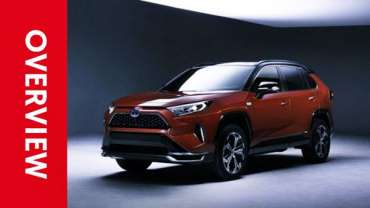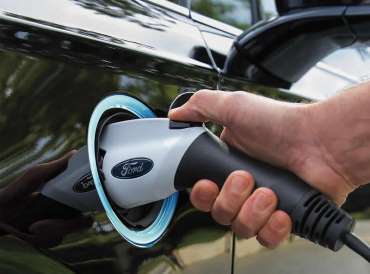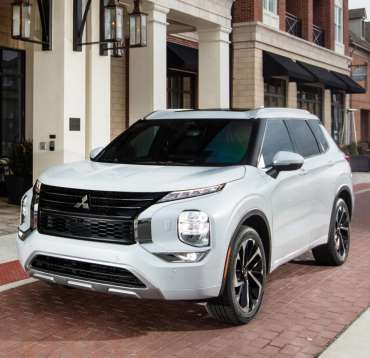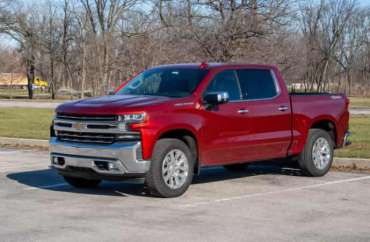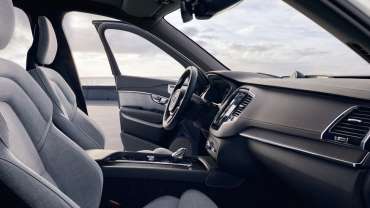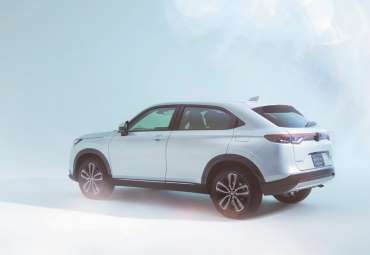
Worldcarblog.com
Toyota Rav4 2023 Hybrid Reviews
The Toyota Rav4 is one of the legendary cars of Toyota. First launched in 1994, the Toyota Rav4 is still being developed today. Recently Toyota has released its latest generation new Toyota Rav4 2023, After sliding first in Japan and the United States, the latest generation Toyota RAV4 began to be marketed in Southeast Asian countries.
Updates occurred on each side of the 2023 Toyota Rav4, ranging from engines to safety features. In general, whatever is in the latest Generation Toyota Rav4 cars is the latest innovation in the automotive industry today. For example, the Hill Assist Control safety feature, this feature will be very useful in the brake system that holds the vehicle for a few seconds so as not to move backward when moving the foot from the brake pedal to the gas pedal, with an HSA, helping the driver not to panic when the vehicle moves backward when on the ramp.
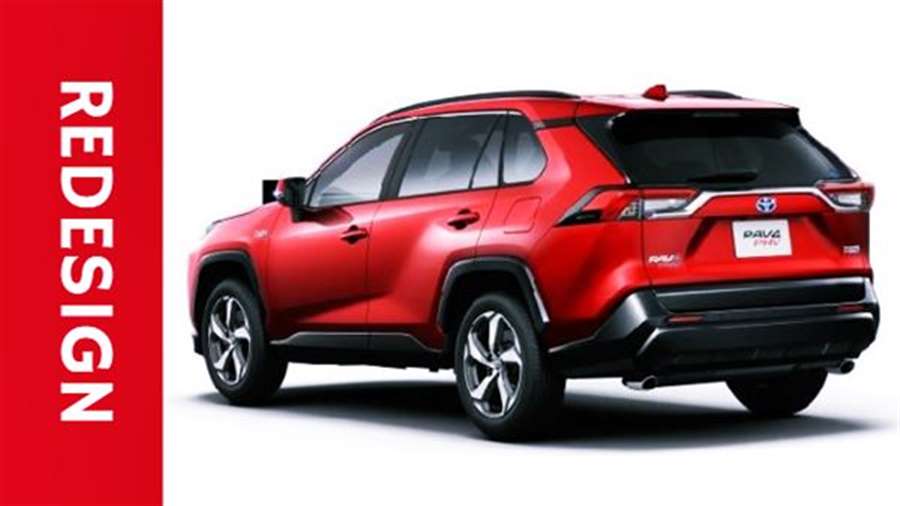
Toyota Rav4 2023 Interior Design
This feature can also be activated or manually disabled by the driver. Generally, there is a button with an image icon of the car that is tilted, and underneath there is a diagonal line that represents the climb. and many others.
Changes can also be felt in the Cabin section of the New Toyota RAV4 2023, the interior design is built very well and equipped with a variety of interesting features that are in it, in terms of interior design looks the latest generation Toyota Rav4 prefers practicality over style. The cabin space is more spacious for storing small cargo, and all the buttons and controls are easy to find and operate. The latest generation 2023 Toyota Rav4 provides many conveniences at the basic level, such as dual-zone automatic climate control, tilt steering wheel, and telescope.
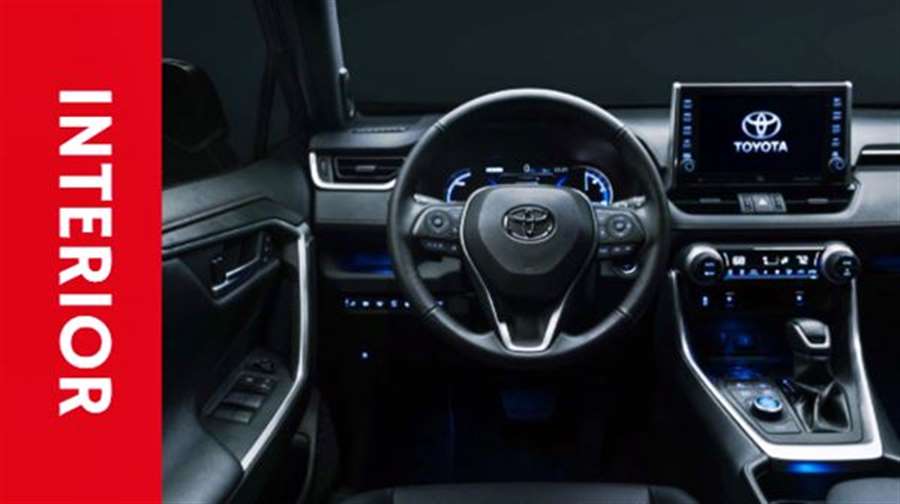
Toyota Rav4 2023 Interior Design
Toyota Rav4 2023 Infotainment
Not much change in the Infotainment section that we get, the latest generation of Toyota Rav4 still comes with a 9.0-inch infotainment screen that emerges from its dashboard and is equipped with multimedia features that Integration Apple CarPlay and Android Auto, as well as onboard Wi-Fi hotspots, are all standard. JBL 11-speaker navigation and stereo systems are available.
Toyota Rav4 2023 Safety Features
currently, we have not obtained the results of safety tests on the latest generation of New Toyota Rav4 2023, but if we refer to the previous generation that has been released by the National Highway Traffic Safety Administration (NHTSA) and the Insurance Institute for Highway Safety (IIHS) has given good value to the RAV4 for accident feasibility. Toyota has been an aggressive adopter of driver assistance features and offers many of those features standard throughout the RAV4 range. we hope for the latest model of the rav4 can get better value than previous generations.
Toyota Rav4 2023 Engine Performance
For its own engine, 2023 All New Toyota Rav4 is equipped with a 2.5-liter four-cylinder engine aided by two electric motors for a combined output of 219 horsepower, this stops a time of 7.4 seconds 60-mph. This model has also been equipped with the best safety system to reduce the risk of collision.
Ford is building a new electric car on Volkswagen's platforms
Ford has announced that it will build a new electric car in Europe using Volkswagen's mechanical frame - a platform for battery-powered vehicles, and that it will spend $ 1 billion on rebuilding a factory in Germany to produce zero-emission cars.
Ford of Europe President Stuart Rowley told reporters that the factory in Cologne will build one model of electric passenger vehicle, which would enter the market in the middle of 2023, and it is possible that another model will be produced there.
He said it was part of Ford’s efforts to offer fully electric or gas-electric versions of all passenger vehicles in Europe by 2024, and all will be fully electric by 2030. The company predicts that by 2030, two-thirds of its commercial vehicle sales will be vehicles in Europe be electric or hybrid.
The agreement with Volkswagen, which allows the use of the mechanical framework of that German electric car company, known by the German abbreviation MEB (modular electric tool set), allows Ford to take advantage of Volkswagen's huge investments in electric cars, while the entire industry is shifting to zero-emission vehicles. pollution.
The Volkswagen platform uses standard mechanical bases such as the battery, wheels and axles, which can be adapted to produce different vehicle models.
Carmakers in Europe must sell more electric vehicles to meet new, lower emission limits for carbon dioxide, the main gas that causes global warming. If manufacturers do not keep the average emissions of their entire fleet below the limit, they will pay large fines. Rowley said Ford can avoid fines.
The company said that commercial vehicles are the key to growth and profitability in Europe, with new products and services through an alliance with Volkswagen and a joint venture between Ford and Otosan in Turkey.
The announced investment, which will be made by 2025, is among Ford's most significant for more than a generation and "underscores our commitment to Europe and the modern future," Rowley said.
Ford said that the investment in the factory in Cologne, with more than 4,000 workers, is starting after Ford's European operations returned to profit in the fourth quarter of 2020.
That investment is part of Ford’s goal to spend at least $ 22 billion on electric vehicles from 2016 to 2025.
This is the new Mitsubishi Outlander - and this time it looks really new
And will he come to Europe? Hopefully, because the new Mitsubishi Outlander looks really good.
The last generation of Outlanders did not look new even at the time of the premiere, while later refreshments did not contribute much. It is possible that this was a deliberate attempt by the company to attract customers who do not run after the news and who rely on proven solutions that are easy to use. Because we can find a lot of positive information about the release version of Outlander today.
Last night, Mitsubishi unveiled the next generation of its flagship model on the Amazon Live platform. Great idea, as more and more people are buying cars online.
The new Outlander is closely linked to Nissan for the first time. It was made on the platform that Nissan developed for the Rogue or X-Trail model, although the designers made sure that the acquisition was not obvious. In this madness, the new Outlander can bravely fight for the title of the most extravagant SUV with the new Hyundai Tucson.
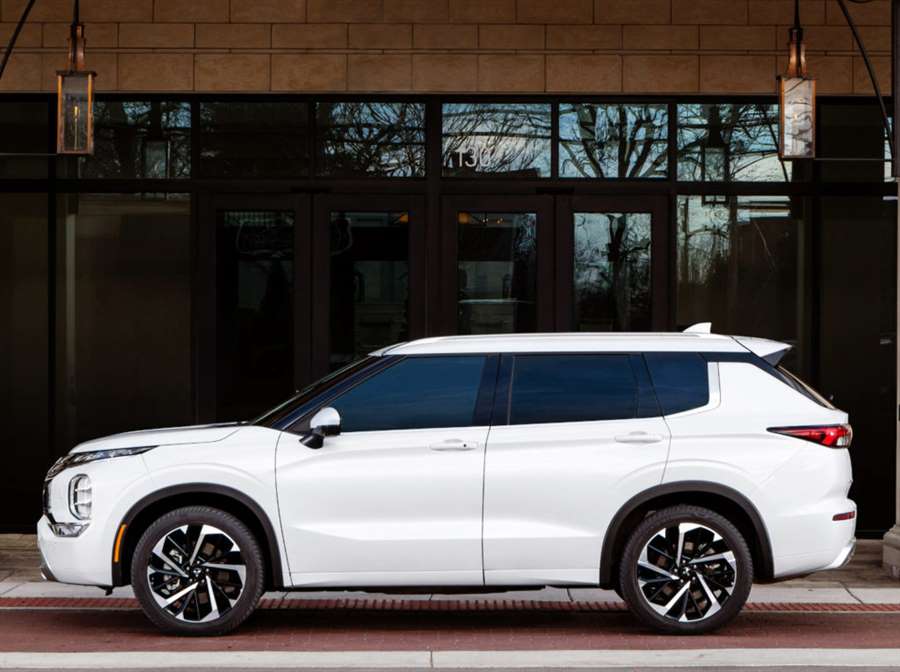
Compared to its predecessor, the Outlander has grown even more. It is 471 cm long, 186 cm wide and 175 cm high. So it’s only 15mm longer, but 51mm wider and 38mm bigger. The wheelbase has also been increased - from 267 to 270.6 cm. All passengers, especially those in the second and third rows, will get an extra inch - as the Outlander will still be available for purchase in the seven-seater variant.
Fortunately, the interior has undergone tremendous changes
Luckily, it depends on who judged the previous generation. Comparing them to the competition, the interior of the previous generation Outlander looked old, which cannot be said for the new generation. It has a screen behind the wheel, a head-up display, a tablet attached to the top of the center console.
It also has classic air conditioning and ventilation controls, while watching the temperature display is similar to screens from the end of the last century which is even very classic. But if something works great and is practical, why would you have to change it.
The interior of the Outlander is shown in two configurations and looks good in both. And again - you can find similarities with Nissan. The only thing that’s a little hard to digest is the silver plate around the gearbox and the engine start button — it looks like it was inserted there at the last minute by a random piece found in some corner of the design studio.
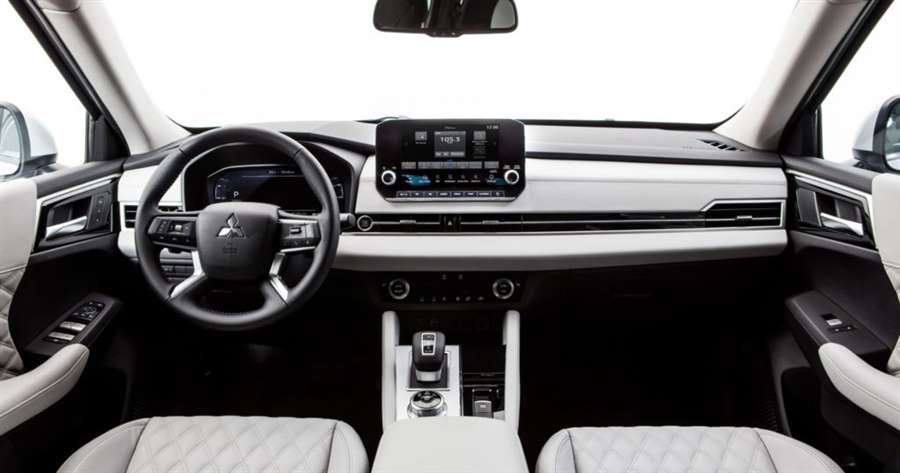
There is nothing to complain about, be happy that it has a 4 × 4 drive
Mitsubishi points out that this is a Super All-Wheel Control 4WD drive, the one it has been bragging about since competing in WRC rallies. It should allow for efficient movement no matter what is under the wheels of the car.
And the movement itself will be provided by a 2.5-liter petrol engine with 181 hp and 245 Nm of torque, driven by a continuously variable 8-speed gearbox. The mentioned numbers do not look impressive, and how they turn into performance - the manufacturer has not revealed that yet. But the chances of seeing a car in this configuration in Europe are pretty negligible.
New Mitsubishi Outlander in Europe?
It will or will not come to the European market - it was not said. In theory, we are still in the period of freezing the European range that the company introduced in the first phase of the pandemic last year.
We are waiting for the official announcement of the European branch of the brand.
2021 Chevrolet Silverado 1500 Review: Few Wows but Plenty of Good
The verdict: The 2021 Chevrolet Silverado 1500 full-size pickup truck is refined, capable and offers an impressive turbo-diesel engine option, but its primary competitors offer more luxury and innovation.
Versus the competition: Certain trim levels of the Ram 1500 are more luxurious than the Silverado 1500, and the redesigned 2021 Ford F-150 has more powertrain choices, including a hybrid that can also run high-draw power tools, but the Silverado nails the fundamentals with an unruffled driving experience and functional interior.
The Chevrolet Silverado 1500 was last redesigned for the 2019 model year, and the 2021 model offers a choice of three cabs, three bed lengths, five engines and eight trim levels. Now available is a new Multi-Flex Tailgate similar to the GMC Sierra’s MultiPro Tailgate, which can transform into a bed extender, assist step and more. Also available are additional camera technology for safer trailering and wireless Apple CarPlay and Android Auto smartphone connectivity.
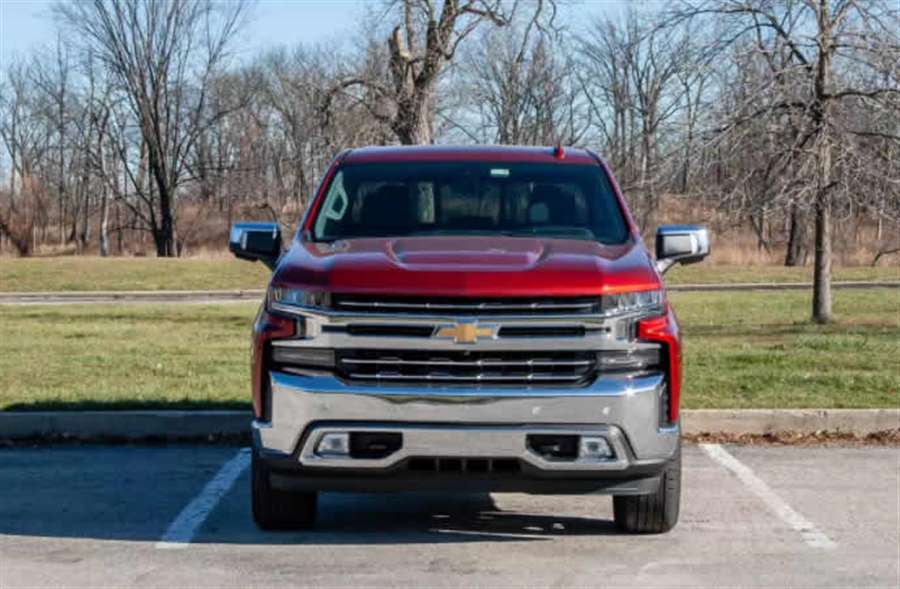
Our test truck was a crew-cab, short-bed LTZ trim with the optional turbo-diesel 3.0-liter Duramax inline-six engine. With optional features and packages, the as-tested price was $60,265, including destination.
Related: 2021 Chevrolet Tahoe Z71 Vs. 2020 Silverado 1500 Trail Boss Z71: How They Compare
Diesel Drivability
The Silverado 1500’s available diesel engine is an impressive performer, delivering smooth power that moves the truck with ease. The engine is rated at 277 horsepower and 460 pounds-feet of torque, and it works with a responsive 10-speed automatic transmission that quickly kicks down when you need more power. Acceleration from a stop is smooth and predictable, and the diesel has adequate power reserves for high-speed passing.
While diesels have a reputation for being loud and unrefined, the Silverado’s diesel engine is nothing like that. There are some characteristic diesel noises, but they’re more of an underlying soundtrack rather than an overwhelming racket. There’s also no excess vibration; it’s as smooth as a gas engine in everyday driving.
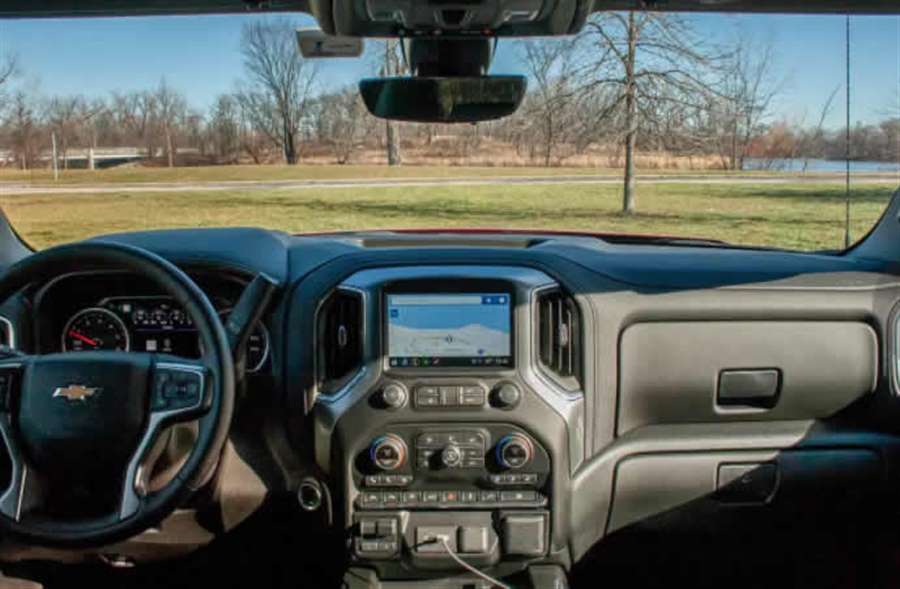
The diesel engine also makes the rear-wheel-drive 2021 Silverado 1500 the most efficient full-size truck you can buy; 4×2 versions are EPA-rated at 23/33/27 mpg city/highway/combined, while four-wheel-drive models are rated 22/26/24 mpg. The next closest competitors are the 2021 Ram 1500 diesel and 2021 Ford F-150 hybrid (see their estimated gas mileage).
The Silverado’s focus on refinement extends to other aspects of the driving experience. Steering response and precision are good, making it easy to place the truck where you want, and the Silverado cruises comfortably at highway speeds with the truck’s tall ride height providing commanding forward views. Unladen ride quality can get a bit bumpy on rougher roads, but the truck’s lack of squeaks or rattles on broken pavement is a testament to its stiff chassis.
Brake-pedal feel isn’t typically a full-size truck highlight, and the Silverado is no exception; the pedal has a numb, spongy feel that makes it seem like you’re stepping on a block of foam.
A Functional but Spartan Interior
Chevrolet took an evolutionary approach when it redesigned the Silverado’s interior a few years back. Ram, meanwhile, chose to create “wow”-inducing cabins in uplevel versions of its 1500, and this dichotomy is evident in the LTZ trim we tested. The LTZ is one of the Silverado’s higher trims, but with average-looking materials and design details, it lacks the level of luxury you get in the Ram 1500 Laramie Longhorn and Limited. Even the Silverado’s top-of-the-line trim, the High Country, isn’t as nice as a high-end Ram.
That said, the Silverado LTZ interior is functional overall with easy-to-use controls and an intuitive 8-inch touchscreen multimedia system featuring wireless Apple CarPlay and Android Auto (corded CarPlay and Android Auto are standard). Some buttons, though — such as those for the driver’s memory feature and heated and ventilated front seats — are unnecessarily small.
The driver and front passenger are separated by a wide center console with two cupholders and a bin with an available wireless charging pad. There’s also a big storage bin under the front center armrest.
Like crew-cab versions of the Ram 1500 and Ford F-150, the Silverado’s rear seating area is spacious. Three passengers can ride comfortably thanks to stretch-out levels of legroom, plenty of headroom and large side windows that provide good outward views. Unlike certain Ram 1500 trims, however, the Silverado’s rear bench seat doesn’t recline. The Chevy’s seat cushion flips up for extra in-cab storage, revealing a mostly flat floor, and there are also available concealed storage compartments in the backrest.
Crew-cab Silverados come with a 5-foot-8-inch or 6-foot-6-inch cargo box. The tall stance of our LTZ test truck resulted in a nearly waist-high box floor, which made the standard integrated bumper steps all the more useful for getting in and out of the bed. A power tailgate is available, but the tailgate is easy to close manually.
A base regular-cab Silverado with the standard 4.3-liter V-6 engine can tow 7,900 pounds when properly equipped, but certain more expensive models are actually rated to tow less; the V-6-powered crew-cab Trail Boss with a regular cargo box has a 7,200-pound towing capacity, the Silverado’s lowest.
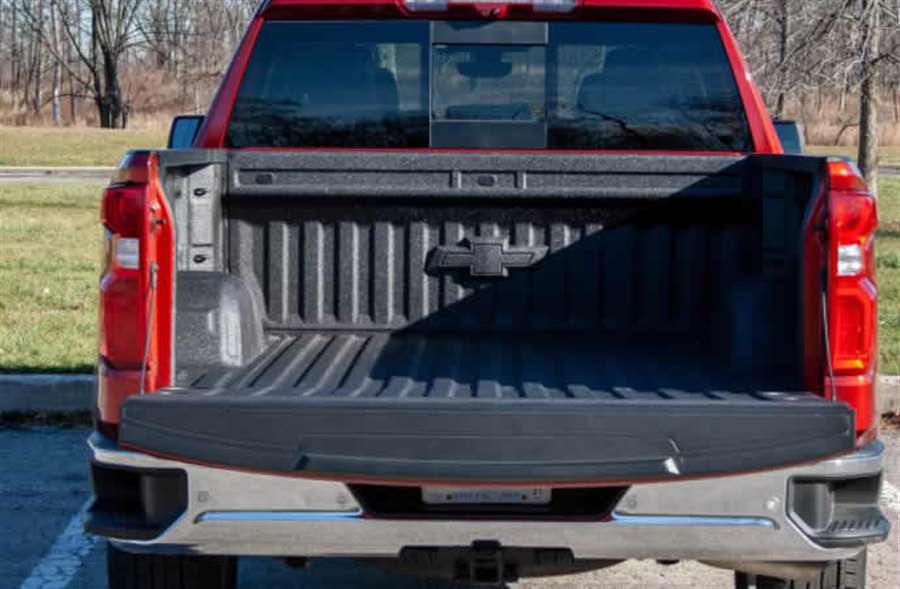
The truck’s highest, 13,300-pound towing capacity is achieved with a double-cab RST trim level with the optional 6.2-liter V-8 and the Max Trailering Package. Towing capacities vary significantly between these extremes — our diesel test truck, for instance, was rated to tow 9,000 pounds — but each Silverado includes a sticker with truck-specific ratings so it’s easier to know its limits.
The Silverado’s optional camera technology also lets you monitor a connected trailer from the truck’s dashboard touchscreen. The system uses auxiliary cameras to show what’s behind a connected trailer when driving or reversing as well as conditions inside the trailer. You can also use truck-mounted cameras to monitor the cargo box or make hitching a trailer easier. There’s also a new view for 2021 trucks that shows whether there’s enough space to change lanes when towing.
Crash Tests, Safety and Assist Features
The crew-cab Silverado 1500 received good ratings (on a scale of good, acceptable, marginal or poor) in all Insurance Institute for Highway Safety crashworthiness tests except the passenger-side small overlap test, where the truck rated marginal. All other large pickups evaluated by the IIHS performed better than the Silverado and its GMC Sierra sibling in this test except for the 2021 Toyota Tundra, which is soon to be replaced by a redesign. (Notably, the redesigned 2021 Ford F-150 had not been tested as of publication, but its results will appear on the organization’s Large Pickups page once completed.) The Silverado’s optional automatic emergency braking system earned a superior score (on a scale of superior, advanced or basic), but the available LED reflector headlights, which go in LTZ models, received a poor rating.
Other optional safety features include blind spot warning with rear cross-traffic alert, lane-keeping assist, a 360-degree camera system, and front and rear parking sensors.
Value in Its Class
You can spend luxury-vehicle money on a Silverado, as the as-tested price of our truck attests, but the same is true for high-end versions of the Ram 1500 and Ford F-150. However, the things that separate the Silverado from its competitors — precise steering and impressive overall driving refinement — don’t require a top trim if one of those isn’t in your price range. The nicest Silverado isn’t in the same league as a top-of-the-line Ram 1500 or Ford F-150, though, so if luxury is what you want, one of those trucks might better meet your needs.
What could be the biggest problem in driverless cars
By eliminating the most common cause of traffic accidents - humans, and introducing autonomous vehicles into traffic, the number of accidents and deaths is expected to decrease. However, these vehicles also represent a completely different type of risk for drivers, passengers and pedestrians.
Autonomous vehicles are artificial intelligence systems that use machine learning techniques to collect, analyze and transfer data, all in order to be able to make the decisions that people make in conventional cars.
However, as zimo.dnevnik.hr writes, like any other IT system, artificial intelligence is also susceptible to cyber, hacker attacks that can jeopardize the proper functioning of vehicles and cause major traffic problems.
What's more, you don't have to be a hacker or an IT expert to streamline the operation of autonomous vehicles - this would be enough to make this happen: add paint to roads to fool navigation or put a sticker on traffic signs, say Stop, to prevent it is recognized by the artificial intelligence system (AI), are just some examples of such possible attacks.
Such situations can lead the AI system to misclassify objects, and that is why it starts behaving dangerously in traffic.
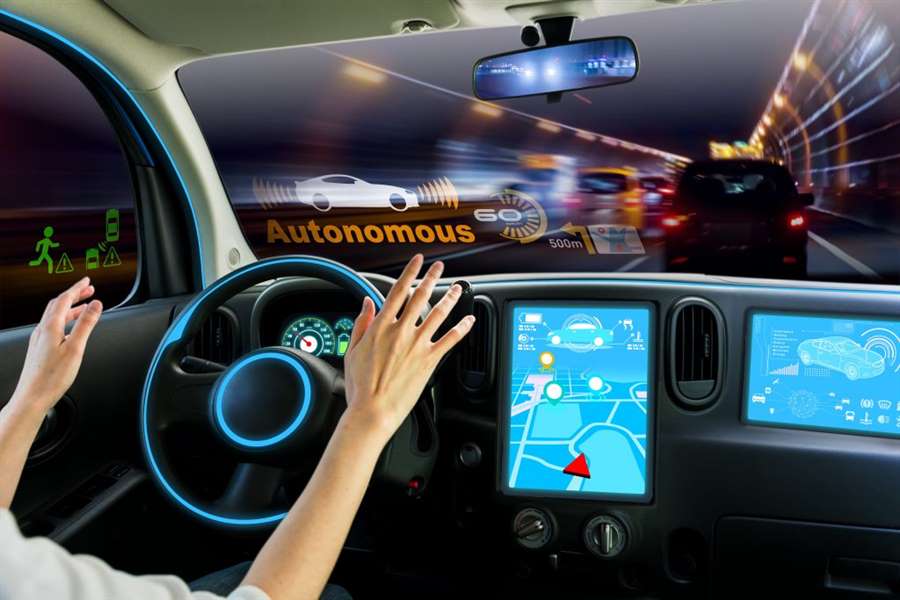
Autonomous vehicle AI systems work constantly to recognize traffic signs, then other vehicles, as well as to assess their speed in order to plan further travel. If we omit unintentional threats, such as sudden failures, these systems are vulnerable to international attacks that have the specific goal of disrupting AI systems and disrupting traffic safety functions.
A new report by the European Union's Cybersecurity Agency (ENISA) and the Research Center (JRC), the European Commission's science and knowledge service, points to cybersecurity risks associated with the introduction of artificial intelligence in autonomous vehicles and makes recommendations on how to avoid them.
When an endangered autonomous vehicle crosses the border of a member of the European Union, its vulnerabilities also cross the border. Safety in that sense should not be a subsequent thought, but a precondition for the reliable release of vehicles on European roads, points out Juhan Lepassaar, Executive Director of ENISA. It is also important that European laws ensure that the benefits of autonomous driving do not jeopardize safety risks.
How can this be prevented
The report also makes several recommendations on how to improve the AI safety of autonomous vehicles.
One of these recommendations is to regularly check AI components throughout their lifetime. Systematic verification of AI models and data is key to ensuring that the vehicle always functions properly when faced with unexpected situations or a malicious attack.
The second recommendation says that continuous risk assessments should be conducted with the help of threat intelligence, which would enable the identification of potential AI risks and the emergence of new threats related to the introduction of artificial intelligence in autonomous driving.
Adequate AI safety policy and AI safety culture should govern the overall supply chain in the automotive industry.
The automotive industry should also embrace a new approach to design for the development and use of AI functionality, where cybersecurity would become a central element of digital design from the outset.
Finally, it is important for the automotive sector to raise its preparedness level and further strengthen incident response capabilities, so that they can cope with the emergence of cybersecurity problems associated with artificial intelligence.
2021 Volvo XC90 T8 Tailored Wool Interior Review: Wooly Bully
Warmer in winter and always cooler than ubiquitous leather.
Why does everybody want a leather interior? These days even cars that aren't lined with cow mostly get swathed in petrochemicals longing to pass for cow, with euphemistic marketing handles ranging from the generic leatherette or vegan leather to trademarked monikers like BMW's SensaTec, Mercedes' MB-Tex, and VW's V-Tex. Some of our favorite car interiors ever have sported cloth seats, from the Porsche 928's psychedelic Pasha checkerboard to the 911's Pepita houndstooth and various tartan plaids. Sadly, they're all but gone today. So it seemed downright newsworthy when a 2021 Volvo XC90 T8 turned up in my driveway swathed in wool upholstery fabric. Volvo calls it Tailored Wool Blend, and I relished every cosseted moment in these thrones.
What Is Tailored Wool Blend And What Colors Are Available?
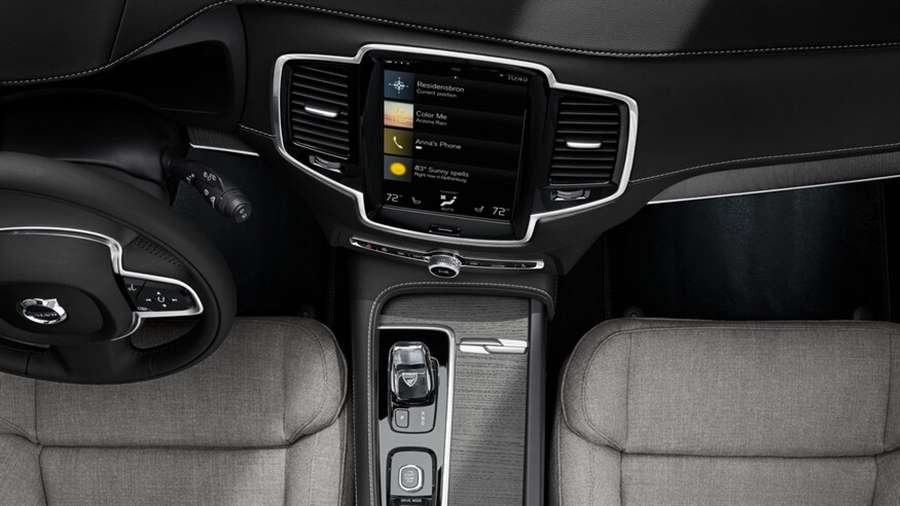
This tweedy weave is comprised of 30 percent wool and 70 percent recycled polyester, so it might be even earth-friendlier than "vegan leather." Tailored Wool Blend appeared as a no-cost option on the 2020 refresh of the XC90 Inscription model in a color called Midnight Zinc. The same option is also available on XC60 Inscription models.
At launch last year, a second color called Slate was offered, but it proved less popular and was dropped for 2021. Volvo does offer another textile, known as City Weave Textile fabric, as a no-cost option on the S60, V60, and XC60 Momentum trim grades. It's in a hue called Blonde and paired with Iron Ore Inlays, and it appears darker and more "plaid" than our Midnight Zinc material.
Inherent Climate Comfort
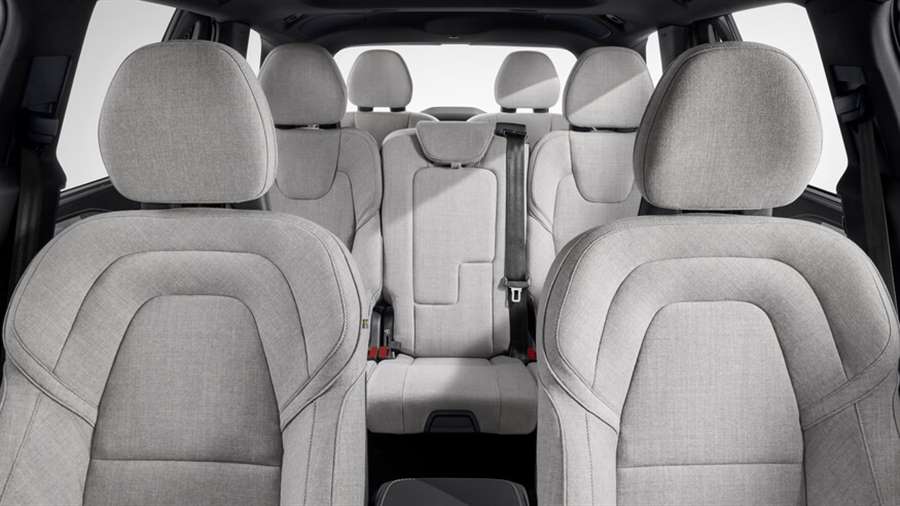
It should surprise nobody that cloth seats always feel warmer in the winter and cooler in the summer—even when contacting bare skin after direct sunlight exposure. The material also presents less resistance to heating, so you'll generally tend to feel the warmth from seat heaters faster. Despite their inherently breathable nature, Volvo at least does not offer a ventilation/seat-cooling option with either its Tailored Wool Blend or City Weave Textile upholstered seating.
What About Cleanup, Care, And Maintenance?
First, how big a slob are you? Inveterate drive-thru diners who regularly juggle sloppy Big Macs while driving will probably find that leather/pleather/vinyl products wipe clean easier. Long-haul car owners who read their owner's manuals and attempt to adhere to the recommendations therein will find that greater care and maintenance is recommended for leather. Case in point: The manual in our XC90 T8 devoted just 84 words to describing how to clean the wool blend but prattled on with 267 words of advice for maintaining the leather, including a recommendation to apply protective cream quarterly. I can tell you this much: Volvo deems Tailored Wool Blend kid-friendly enough to offer its $300 integrated center booster cushion. I'd cheerfully order up a textile interior and just apply some Scotchgard from time to time.
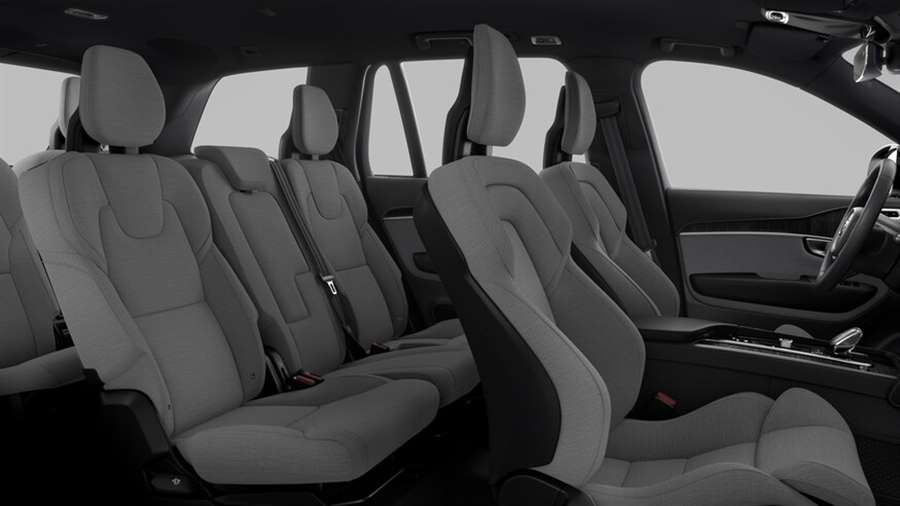
Might The Fad Be Returning?
Way back in the era of chauffeur-driven "town cars" featuring an enclosed passenger compartment and an exposed front seat, Jeeves sat on durable, weather-resistant leather, while His and Her Grace luxuriated in mohair, wool, or other sumptuous fabrics. Velvets and other fabrics remained popular in luxury cars well into the '60s, and wool remains the fabric of choice for "Toyota's Rolls-Royce"—the Century—because it's deemed more dignified; fidget as you will, a wool seat will never make the flatulent noises leather can. Bentley has just reintroduced a Mulliner Tweed interior, using fabric sourced from Scotland, though it's generally used to adorn the door panels. (Of course, companies like Bentley and Rolls-Royce will cheerfully swaddle any part of their cars in any material you desire if the price is right.) We must point out that one of our favorite cloth upholstery offerings of all time remains available on the 2021 Volkswagen GTI: Clark Plaid cloth inserts. Come on, Tesla, why not double down on your new Plaid powertrain by offering a nice tartan upholstery package?
Quite different: Honda unveils new HR-V hybrid (PHOTO)
Honda has unveiled a new generation of its compact crossover HR-V. In addition to the new design, this model will be offered as a hybrid electric vehicle, and it will arrive in Europe at the end of 2021.
The introduced HR-V is the latest model in Honda's range that bears the emblem e: HEV (hybrid electric vehicle). In addition, now this compact crossover comes for the first time with a rather accentuated coupe line.
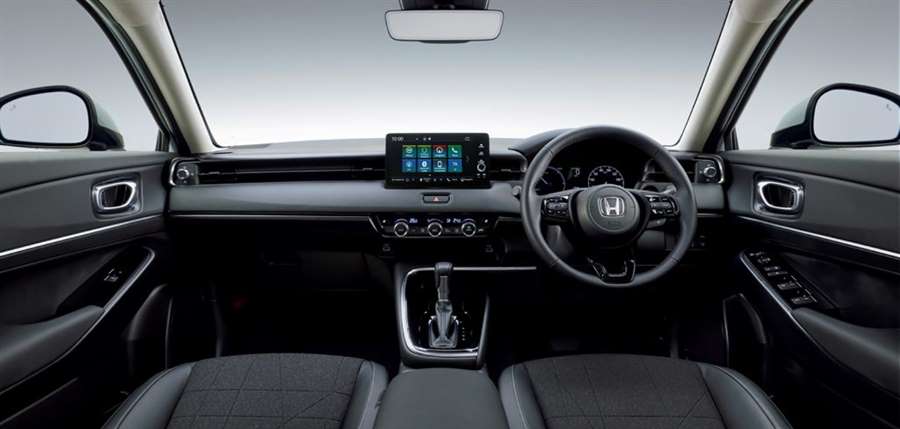
It also has a new integrated radiator grille, a long, lower hood and sharper, more vertical lines that have allowed this model to retain a spacious interior for four passengers, as offered by its predecessor.
The new HR-V also retains the familiar seats, which can provide a flat boot floor after folding down the backrest or folding up. Capacity data has not yet been disclosed.
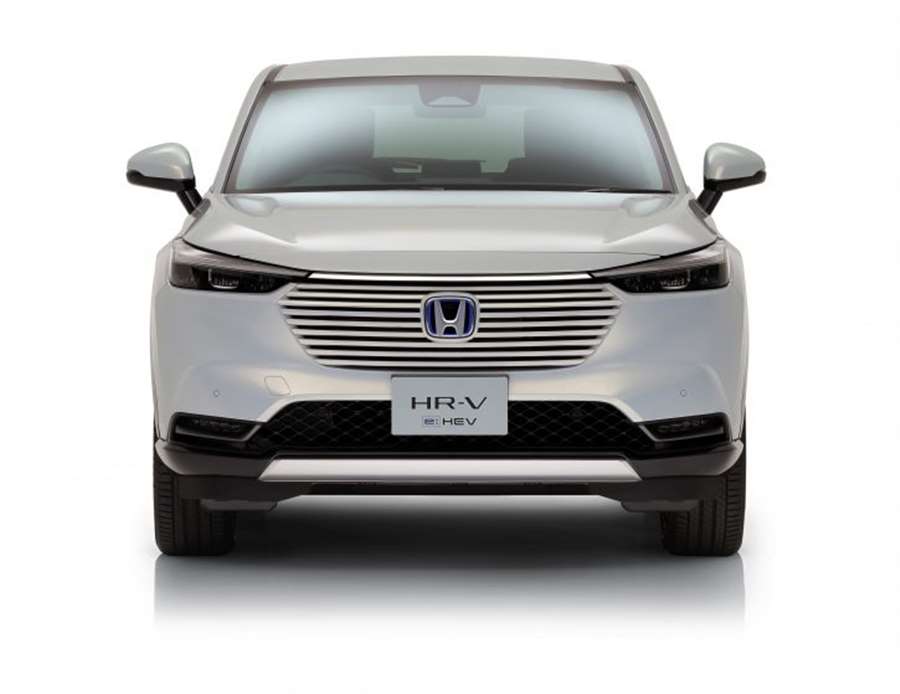
The cabin is now modern and minimalist with a horizontal instrument setup.
A new crossover, in line with Honda's goals of electrifying all major models by 2022, is expected on the European market later this year.

